Utica Zoo Interactive Map
Click on any of the symbols or buildings to learn more! Information will appear to the left of OR below the map depending on your screen size (for most phones, look below the map)!
Interactive Zoo Map
CLICK ON AN ICON OR BUILDING TO LEARN MORE!

African Lion
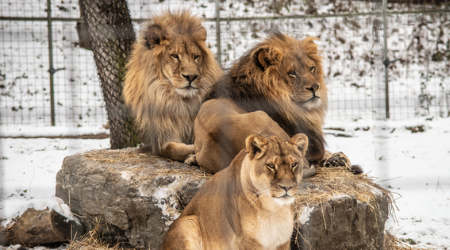
Despite being commonly referred to as the King if the Jungle, African Lions are not actually found in jungles and are most commonly found in savannahs. That being said, the title of "King" does a great job at showcasing how symbolic the lion has become across the world as a symbol of power and majesty. And it is easy to see why! With their huge size, flowing manes, and powerful roars, these cats are definitely a sight to behold. All this being said, African lion populations have become more and more threatened over the last few decades. While lions used to live in most parts of Africa, today fewer than 21,000 remain in all of Africa. Most of these wild lions can be found in the East African countries of Tanzania and Kenya as well as the Southern African countries of Botswana, South Africa, Zambia, and Zimbabwe where conservation efforts and wildlife preserves are more common.
Our Lions:
Donovan (Male) - Born May 11, 2011
Murphy (Male) - Born June 6, 2012
Coky (Female) - Born June 6, 2012
All three of our lions were born at the Utica Zoo from the same parents.
Striped Hyena
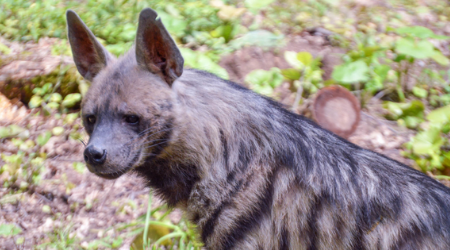
Striped hyenas are one of the 3 types of hyena species in the world. They can be found stretching from Asian countries such as India and Pakistan all the way into north African countries and as far west as Senegal and Mauritania. They prefer grasslands, open woodlands, and bushy and rugged regions where they travel in small groups and feed on carrion that is left around their habitat. That being said, they can hunt when they need to, but not nearly as much as their cousins: the spotted hyenas. While the striped hyena has no natural predators, it does often come into conflict with humans. They have been known to kill humans, especially children, and they are often poisoned and trapped for preying on livestock or raiding farms. Some of their body parts are also believed to have medicinal value.
Our Hyenas
Kani (Male) - Born May 15, 2012
Imara (Female) - Born February 22, 2013
Hartmann's Mountain Zebra
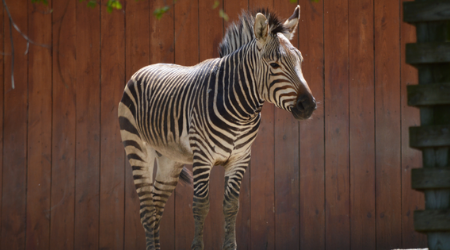
There are two species of mountain zebra in the world: Cape and Hartmann’s. Cape mountain zebras can be found up to 2,000 meters above sea level in South Africa, but move to lower elevations in the winter. Hartmann’s mountain zebras on the other hand can be found in the arid, mountainous regions of the Namib desert of Namibia and Angola. Due to this dry habitat, these crepuscular zebras have to consistently travel between locations during the early morning and evening to find drinkable water. In fact, Hartmann’s mountain zebras are known to dig down 3 feet to uncover hidden water. This action sustains the zebra populations AND benefits plenty of other desert animals as well. When they aren’t traveling or grazing, these zebras are commonly found at play. Types of play include chasing, racing, play-fighting, and challenge games. Challenge games usually consist of nose-to-nose contact followed by mutual grooming. All of these activities help to increase the bond between the zebras in a herd.
Our Zebras:
Rundu (Male) - Born December 28, 2011 Zecora (Female) - Born November 28, 2013
Zara (Female) - Born July 30, 2022
Common Ostrich
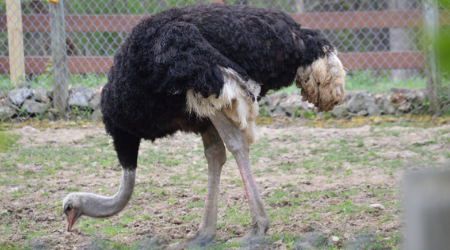
Ostriches are the largest bird in the entire world. They can be found all across the African continent in typical flocks of between 2 and 10 birds, though they can reach flocks upwards of 100. While they are a ratite which means that that are unable to fly, they are capable of running at tremendous speeds. In fact, they can reach up to more than 40 miles per hour when they want to. When they are running at this speed, they can cover a distance of more than 10 feet with each stride. As you can imagine, these powerful legs are also capable of delivering a devastating kick that – in combination with their 4-inch claws – can kill a lion in one blow. However, you can normally find ostriches merely grazing around their habitats. Although Ostrich numbers have drastically declined over the last 200 years, they are still classed as Least Concern by the IUCN. In the 18th century, ostrich feathers were so popular in ladies’ fashion that the ostrich disappeared from all of Northern African countries. If not for ostrich farming, which began in 1838, the ostrich would probably be extinct. Today, ostriches are plentiful and are farmed and hunted for feathers, skin, meat, eggs, and fat.
Our Ostrich:
Boomer (Male) - Born 1999
Ruby (Female) - Estimated Date of Birth August 2020
Sapphire (Female) - Estimated Date of Birth August 2022
African Painted Dog
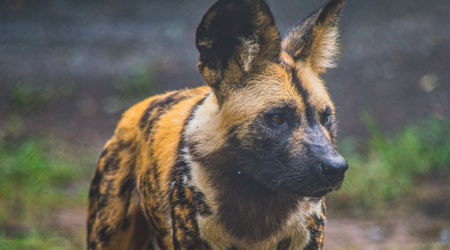
Also known as the African Wild dog, Cape Hunting Dog, or – simply – Painted Dog, African Painted Dogs are an endangered canine native to Botswana, Zimbabwe, Namibia, Zambia, Tanzania, and Mozambique. They hunt in packs consisting of between 6 and 20 (or more) dogs. Packs on the larger side are capable of hunting more efficiently and successfully, can prey on larger species, and have a better chance of protecting their kills from scavengers. This decreases the quantity of required hunts, which reduces the pack’s energetic costs and risk, increasing overall fitness. Painted dogs hunt cooperatively in a relay type form taking turns running after the prey. Painted dogs depend on their ability to run for a long time without getting tired so they can outlast their prey. They can run up to 37 miles per hour for up to 3 miles which allows them to catch prey with ease. All of this makes painted dogs one of the most successful hunters in all of Africa, catching prey 70 to 90 percent of the time (lions are only successful 30 to 40 percent of the time). Unfortunately, due to their declining population, it is become more and more rare to find large packs. Their primary threats include human expansion, being hunted by farmers fearing – inaccurately – for their livestock, and getting caught in traps left by poachers desperate for a quick profit through “bush mean” OR by traps intended for big game animals (which coincidentally also happen to be Painted Dog prey).
Our Painted Dogs:
Charlie (Female) – Born November 20th, 2018
Ada (Female) - Born November 20th, 2018
Rosie (Female) - Born November 20th, 2018
Canada Lynx
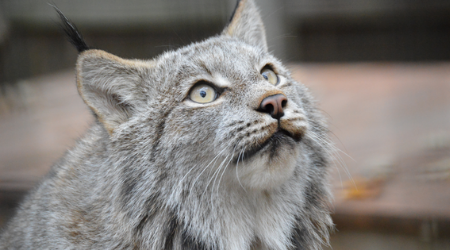
These moderately sized cats can be found amongst the snowy, forested areas of northern North America. They have large paws that help them navigate their snowy habitat in search of their primary source of food: snowshoe hares. While their large paws do prevent them from running quickly, these lynxes have become spectacular ambush predators and will often surprise their prey by leaping on them from ledges and trees. In the past, the Canada lynx could be found across the entire northern expanse of the western hemisphere. However, today the lynx is becoming far less common due to human expansion and the destruction of their natural habitat. For instance, snowmobile trails and roads are detrimental because they open up the snowy, forested homes of lynxes to potential predators like cougars and coyotes as well as competition from rival animals such as bobcats.
Our Lynxes:
Denali (Female) - Born May 15th, 2018
Jack (Male) - Born April 17th, 2020
Mexican Wolf
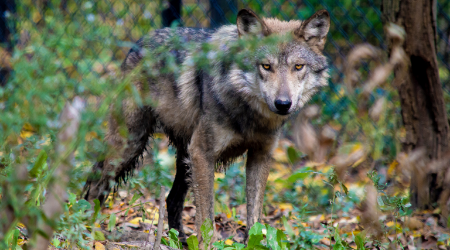
Despite being the smallest wolf subspecies in North America, Mexican wolves are still extremely important to the southwestern deserts of North America. Dating back to the 14th century, the Aztec empire revered the Mexican wolf. There is evidence of these Pre-Columbian people using these wolves for sacrificial ceremonies, wearing their skulls and pelts as religious clothing, and giving them ritualistic burials in the Templo Mayor (or primary holy building of the Aztec city of Tenochtitlan). According to archaeologists and historians such as Leonardo Lopez, Mexican wolves were related to the Aztec sun and war god Huitzilopochtli and were thought to be spirit guides for warriors in the underworld. In a more modern context, however, Mexican wolves are integral to the stability of their ecosystem. Since they are one of the primary carnivores in the southwestern area, if wolf populations decline then the populations of their primary prey – elk, deer, and wild pigs – will grow exponentially. In turn, this leads to more grazing and a decrease in the balanced floral diversity that keeps their habitat healthy. This is one of the many reasons that huge conservation efforts have been made to keep Mexican wolf populations stable. Throughout the 1900s, these wolves were hunted by farmers in the area out of fear for their livestock. This almost drove these amazing canines to extinction. Thankfully due to breeding and reintroduction programs, wolf numbers are slowly increasing every year. Today, you can find wild Mexican wolves hunting in packs across the Arizonian and Mexican deserts. These packs have complex social structures and are lead by a mated, alpha pair. Together, they work together to run down their prey and – thanks to their effective teamwork – are capable of taking down animals that are substantially larger than they are themselves.
Our Wolves:
Ah Tabai (Male) - Born May 8th, 2016
Fenrir (Male) - Born May 8th, 2016
Maitland (Male) - Born May 8th, 2016
Arctic Fox
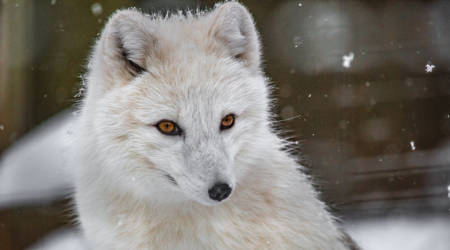
As the red fox's range expands into that of the arctic fox, these two species compete for food. The larger red fox also preys on the smaller arctic fox. Polar bears and wolves also threaten the arctic fox in two ways. When larger predators decline in numbers, they leave behind less carrion for the scavenging arctic fox. Bears and wolves also prey upon the arctic fox as a source of food. Despite all these hazards, arctic foxes are remarkably successful in most areas of their range.
Did You Know?!
- Arctic foxes have a great sense of smell and excellent hearing. Their small, pointy ears can hear their prey moving around in underground tunnels. When an Arctic fox hears its next meal scurrying under the snow, it leaps into the air and pounces, breaking through the layer of snow right onto the prey underneath.
- The arctic fox has a unique system of heat exchange that will not let her start shivering until the temperature drops to an astounding −70 °C (−94 °F).
- An artic fox’s fur changes colors depending on the season. In the winter months, it is a pure white. During the summer months it has a blue tint to it.
- Arctic foxes live in burrows with extensive tunnel systems. During blizzards, they also burrow into the snow for protection from the elements.
Our Foxes:
Athena (Female) - Born May 20th, 2012
Mariah (Female) - Born May 20th, 2012
Mexican Spider Monkey
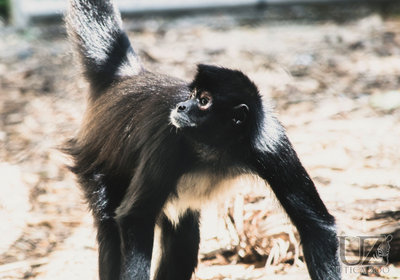
This very social primate can be found in groups – or troops – scattered across the Central and South American rainforests of Mexico, Guatemala, Honduras, Belize, and El Salvador. During the day, they tend to split up into smaller groups to search for tasty fruits to eat before coming back to their larger, communal group to socialize in the evening. During this socialization they can be found grooming, playing, or – in some circumstances – fighting amongst each other. All of these actions help to define social relations among monkey troops and – in many ways – helps to bring them closer together. Since spider monkeys are arboreal and exist almost entirely in the trees of their native rainforests, the survival of these monkeys is entirely dependent upon the survival of the forests. They require large tracts of primary forest to survive, and are vulnerable to deforestation. They are some-times hunted by humans for meat and captured for the pet trade. Because of low reproductive turnover, they cannot quickly replenish their numbers when affected by these events. As a result, Mexican spider monkeys have completely disappeared from some areas where they were once common.
Our Spider Monkeys:
Manuel (Male) - Born 1996
Negra (Female) - Born 1997
White-Handed Gibbon
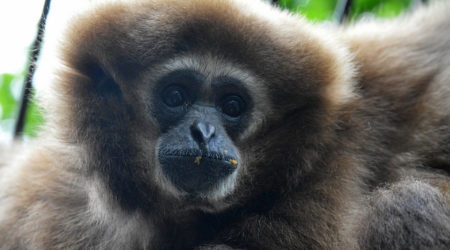
White-handed gibbons, or Lar gibbons, are an arboreal primate species found across various countries in Southeastern Asia. They are most notable for their distinctive whooping call that they do in order to communicate and bond with other gibbons. Gibbon groups usually consist of 2 mated adults and up to 4 offspring and cover upwards of 100 miles of territory. You can usually spot them swinging among the treetops of their forests using their long arms with a method called brachiation. This unique motion involves the gibbon swinging their entire body like a pendulum to maintain momentum, save energy, and launch themselves up to 30 feet forward! Unfortunately, their populations have been declining in recent years. This is due, in part, to the flourishing illegal pet trade in Thailand in which they are hunted, captured, traded, and exploited. The deforestation of their forest habitat is also a threat and is becoming more of a problem. Protected conservation areas provide the greatest survival rates for populations of this species, although the ongoing agricultural development through these areas increases both fragmentation and access for hunters.
Our Gibbons:
Snowflake (Female) - Born January 22, 1988
Yoda (Male) - Born June 14, 1994
Dooku (Male) - Born January 30, 2023
Jacob Sheep
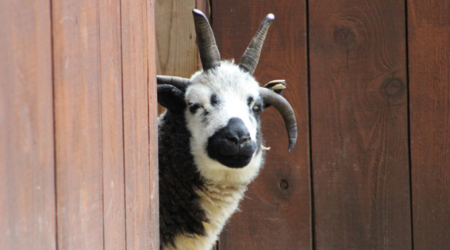
Jacob Sheep is a domestic breed of sheep found in the United Kingdom. They are distinguished by their wool’s unique color pattern and multiple horns. As for the former, they have black wool with white patches. As for the latter, both male and female Jacob sheep have horns. They can have anywhere from 2 to 6 of them with males typically having larger horns. As a domestic breed, they are known for being very easygoing and simple to take care of since they are so resilient and docile. While Jacob Sheep were originally used to decorate the yards and gardens of large estates, today Jacob Sheep are primarily for wool and meat.
Our Jacob Sheep:
Millie (Female) - Born 2020
Mabel (Female) - Born 2020
Pallas's Cat
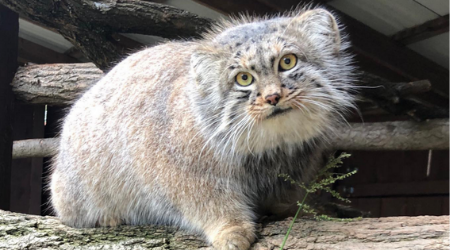
Named after naturalist Peter Pallas, Pallas’s Cats are found in the Eurasian grassy steppes from the Mongolian deserts to the Himalayas. They have been called the most expressive – or grumpiest – cats in the world due to their snaggly teeth and rounded pupils making it easy to anthropomorphize them. However, they are not actually perpetually upset. That being said, they are primarily solitary and definitely prefer being hidden and unnoticed. They spend most of their time hopping between rocky dens in search of their favored food: the small, mountainous rodents known as pikas. Unfortunately, Pallas’s cat populations have been declining due to human expansion shrinking their habitats and limiting their food supply.
Our Pallas Cat:
Tate (Male) - Born March 28th, 2017
Miniature Donkey

Alpaca
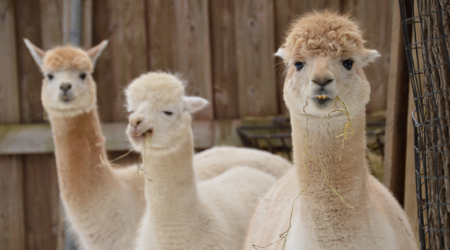
While similar in look to their cousins the llamas, alpacas are a smaller species that prefers to travel in herds than the primarily solitary llamas. Due to this herd nature in addition to their softer wool and docility, alpacas became domesticated around 6,000 years ago in Peru. Today, wild alpacas no longer exist. They are most popular for their fibers which are known to be silky and strong: one of the finest types of natural fleece in the world. Consequently, these can be used to make very popular and luxurious clothes which can be quite pricey!
Our Alpacas:
Paqo– Born June 13th, 2008
Kachay– Born September 20th, 2008
Ozomatli– Born September 20th, 2008
Zebu
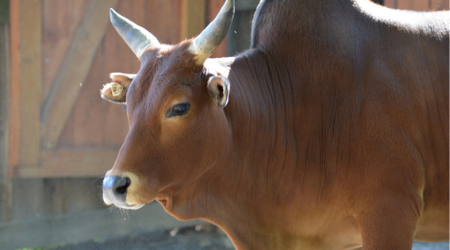
Thought to have originated from India, Zebu are a domesticated bovine from the jungles of South Asia that are valued for their milk, meat, leather, and horns. They are one of the oldest breeds of cattle that we know of dating back as far as 6000 BC. Today, reports show that there could be up to 70 different Zebu cattle types in the world. They are distinguished by their large dewlap and the hump on their upper back. The latter – like a camel’s hump – is used to store fat which is then used in hot, dry spells when access to food and water is limited. While they can be used for food, most areas use them primarily for hauling, riding, and dairy. In fact, Zebu are considered holy by Hinduism in their homeland of India.
Our Zebu
Zeke (Male)– Born April 9th, 2008
Zack (Male) – Born September 23rd, 2018
Ziti (Male) - Born August 10, 2023
Zack came to the Utica Zoo from the Washington Park Zoo.
Zack and Ziti are a domestic/dwarf Zebu and is noticeably smaller than Zeke.
North American Beaver
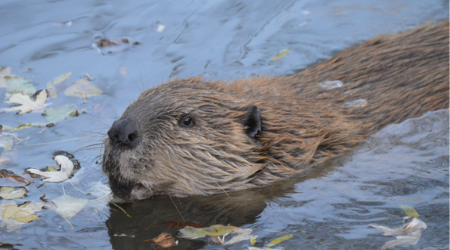
Beavers are the largest rodent in North America and can be found across marshlands throughout the entire continent. They are the only species on the entire planet that are known for building dams to block waterways and create ponds. This is important for the health of the ecosystem, and also act as landscapes for the beavers to them build lodges in. These protective shelters are built partially in the water and can only be accessed through swimming up in to them. All of these construction activities require sticks and logs which beavers obtain by gnawing down trees in the area around them. They also have very smooth and waterproof fur that allows them to easily navigate between the land and water. This fur was very popular throughout the early days of America and beavers were almost hunted to extinction due to the high demand for their pelts among Europeans. Thankfully, hunting eventually slowed and beavers have since made a comeback.
Our Beavers:
Jolene (Female) - Estimated Date of Birth March 2021
Vietnamese Pot-Bellied Pig
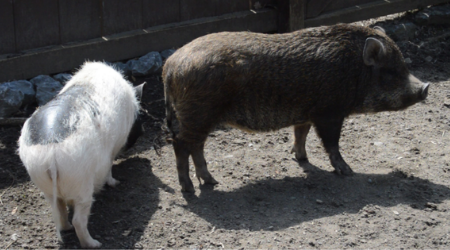
Vietnamese pot-bellied pigs are a native swine of Southeast Asia (primarily in the Nam Định province of Vietnam) and since the 1980s have been imported into the United States as pets. In the wild, these pigs tend to form herds of considerable numbers. In these herds, the pigs communicate with a large repertoire of sounds including grunts, snorts, squeaks, squeals, and more while using their snouts to forage for food in the dirt.
Our Pigs:
Bacon (Male) - Born September 1st, 2017
Piggy Sue (Female) - Born March 13th, 2009
Nigerian Dwarf Goat
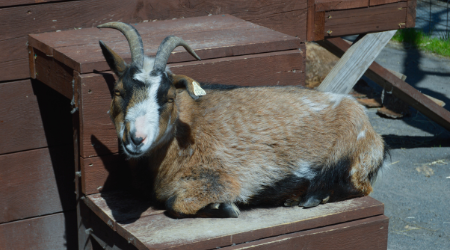
Nigerian Dwarf Goats derive from a variety of small goats imported from Western African countries such as Nigeria, Ghana, Guinea, Gambia, Liberia, Mali, Niger, and Senegal to the United States between 1930 and 1960 for display in zoos. While initially used as a show breed due to their appearance and docility, Nigerian Dwarf Goats eventually became valued for their milk production as well. Today, they are recognized by the American Dairy Goat Association!
Our Goats:
Tasha (Female) - Born July 13, 2010
Arya (Female) - Born June 27, 2014
Cloe (Female) - Born March 4, 2023
Stella (Female) -Born March 4, 2023
Zozie (Female) - Born March 5, 2023
White Naped Crane
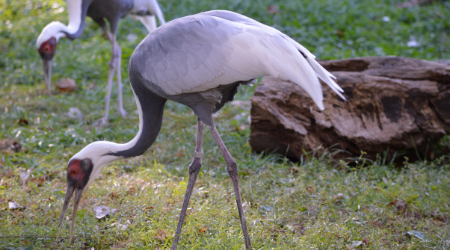
Named for the dark gray color of their feathers with a white-stripe on their neck, these cranes can be found across marshlands throughout eastern Asian countries such as Mongolia, Korea, Japan, China, and southern Siberia. Being primarily social birds, they can often be seen digging for roots, seeds, and insects in the ground or fishing for fish in the nearby water alongside a number of other cranes. They are also known for creating long lasting, monogamous bonds with their mates and can often be found participating in mating displays with each other. In these displays, the two participants will call back and forth to each other while looking upwards and flapping their wings in a dance. If successful, the pair will then nest with each other in the spring season right on the open wetland. From here, these cranes are known to be staunchly territory and defensive of their eggs.
Our Cranes:
Creamy (Male) - Born May 23rd, 1981
Peaches (Female) - Born June 2nd, 2002
Creamy is one of the oldest cranes in human care!
Reeves's Muntjac
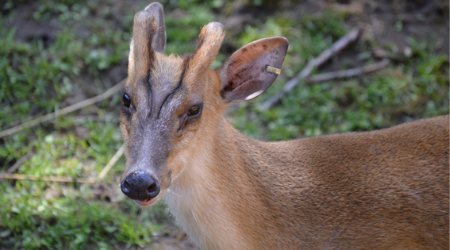
Commonly referred to as barking deer due to the sounds they make when scaring off predators, defending their territory, and initiating mating rituals, these small ungulates can be found naturally in southeastern China and Taiwan. However, due to human interference and introductions, they can now be found across the United Kingdom, Ireland, and parts of Europe as well. Typically found being by themselves or in pairs, muntjacs can be found grazing on bushes, berries, fungi, and grasses around their territories. Speaking off, they frequently mark their territories to deter other muntjacs using the two prominent, preorbital glands on their face. In fact, males will aggressively drive off trespassing males and can be quite aggressive about it. While their antlers may be small, they can be used to push and gouge threats and competition. If that fails, they also have a set of 2-inch long, downward pointing canine teeth that can cause some substantial damage when needed.
Our Muntjacs:
Xiao Yi (Male) - Born May 26th, 2013
Bennett's Wallaby
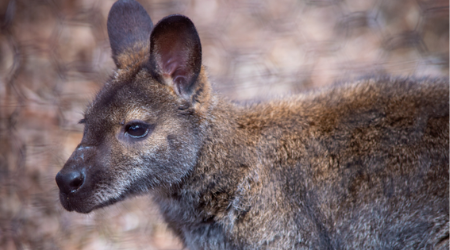
Wallabies are a species of small marsupial species that are often mistaken for kangaroos. Various types of this animal can be found naturally all across Australia, and due to human introductions they can also be found in New Zealand, Tasmania, and even as far west as Ireland, the United Kingdom, and parts of Europe. Bennett’s wallabies – or red-necked wallabies – are primarily distinguished by their gray-coats with reddish shoulders. They are a mostly independent type of wallaby and only really come together in groups when there is an abundance of resources or when mating. While they do have a few predators around, their populations are relatively unchecked and it has led them to be labeled as pests in some areas. In fact, local governments sometimes issue licenses to kill wallabies in order to prevent them from devastating crops or pastures. Occasionally, wallabies are also harvested for their meat.
Our Wallabies:
Chrissy (Female) - Born January 1st, 2011
Peanut (Male) - Estimated Date of Birth January 30, 2020
Sriracha (Female) - Estimated Date of Birth May 13, 2021
Tapioca (Male) - Estimated Date of Birth March 17, 2022
Cheddar (Undetermined) - Estimated Date of Birth February 9, 2023
Emu
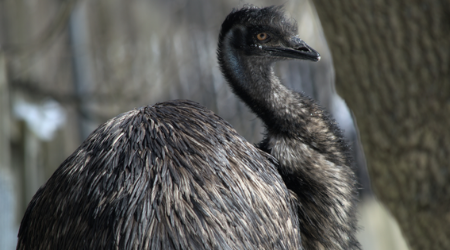
The second largest bird in the world, emus can be found across the Australian mainland typically near the bush regions. Like all other ratites, they are incapable of flight and – instead – travel by running upwards of 30 miles per hour while using their wings for balance! However, unlike a lot of other birds. their feathers a stiff and can be rattled as a sign of intimidation to predators. In addition to this, they are known for making low, rumbling sounds from a special pouch in their throat. This trill can be heard up to half a mile away! They are vegetarians and feel on grains, grasses, and other plants. And while they are generally non-aggressive due to their lack of predators, they can deliver a powerful kick when threatened which can make them dangerous. In the past, they were used for their meat by local populations when needed, they often coexist with humans peacefully. That being said, in 1932 the great Emu War was declared in response to emus pillaging local villages of their crops during a particularly dry season. This conflict saw the Australian military mobilize to defend local farms from the persistent birds. While it saw some success, it has generally been remembered as a failed effort, and it is widely stated that the emus won the war.
Our Emus:
Diggery (Female) - Born March 2006
Doo (Female) - Born March 2006
Visayan Warty Pig
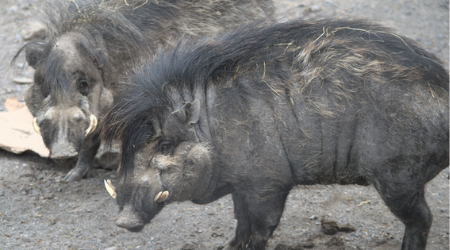
Named for the three pairs of fleshy warts that appear on their face (which are thought to protect their face when fighting), Visayan Warty Pigs are one of the most critically endangered swine species on the planet. Not much is specifically known about this species due to the fact that they were only recognized as a distinct pig species back in the 1990s. This has been made even more difficult due to the rarity of this pig species in the wild. Having disappeared from about 98% of their historic range, only small numbers of this species can be found on 2 of the Visayan islands in the Philippines (for reference, there are 7,641 islands in the Philippines). In fact, the exact number of pigs remaining in the wild is unknown. All this being said, it is known that they travel in groups of four to five where they are found digging and foraging for roots, tubers, and insects to eat.
Our Pigs:
Axl (Male) - Born June 12th, 2008
Ozzy (Male) - Born June 10th, 2008
Ace (Male) - Born September 9th, 2008
Transcaspian Urial
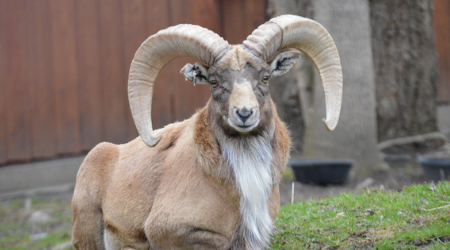
Native to western central Asia from Iran to Kazakhstan to Pakistan to northern India, the Transcaspian Urial is the modern domestic sheep’s ancestor as well as the oldest line of the Ovis species. They often inhabit lower elevation areas where grazing opportunities are more common. That being said, this brings them into more contact with farmers and creates competition between livestock and wild urials. Due to this, urials are often hunted in order to eliminate this threat to local farmers’ livelihoods. These urials are also threatened by poachers who enjoy obtaining the large horns of males. These 2.5 foot long horns are used within urial groups to determine the leader. Whomever’ s horns are the largest and most curled gets that accolade. Should this determination be difficult to make, males will compete with each other by fighting with their horns until a winner is decided upon.
Our Urials:
Pyrai (Female) - Born April 20th, 2021
Saimina (Female) - Born April 11th, 2014
Aankhen (Male) - Born May 10th, 2016
Bactrian Camel
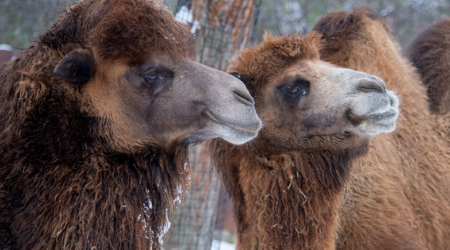
Unlike their more widely known cousins – the 1 humped Dromedary camels of Northern Africa and the Middle East – the 2 humped Bactrian camels can be found across the Gobi desert of Mongolia and China. Do to their arid climate, a camel’s humps hold fat which can help sustain them during long, dry spells without much food or water. Consequently, the larger and more erect a camels’ humps are helps dictate how healthy they are. Additionally, due to the wildly fluctuating temperatures of their home desert, Bactrian camels have seasonal coats that they grow and shed to help them survive temperatures ranging from more than 100 degrees Fahrenheit to -20 degrees Fahrenheit.
Our Camels:
Najla (Female) - Born May 20th, 2005
Furlow (Male) - Born February 26th, 2010
Bald Eagle
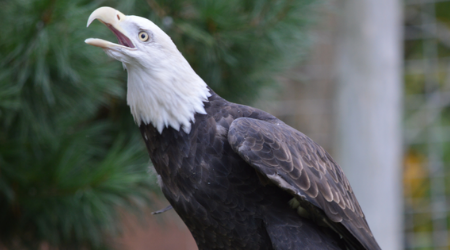
Known for being the national bird of the United States, these eagles are well known for the white feathers that adorn their head. Adults make massive nests weighing upwards of 2,000 pounds that they return to every year to roost and hatch another brood. While they are known for primarily eating fish, they have also been reported harassing smaller raptors – such as osprey – into dropping their food. While originally a very prominent species across the North American continent, by the mid-1900s bald eagles started becoming much more rare. This is due to them being the victim of trapping, hunting, and side-effects from various pesticides causing reproductive issues. Thankfully, initiatives were started and in 1973 they were listed as a protected species under the Endangered Species Act! Through this, dangerous pesticides were banned and reproduction programs began. And with the help of conservation organization and zoos, by the 1990s the Bald Eagle population had stabilized, and in 2007 it was at a comfortable enough size to be removed from the list of endangered species!
Our Eagles:
Ginger (Female) - Born 1996
Colden (Male) - Born 2005
Spirit (Male) - Born 2003
All of our eagles were born in the wild and injured. After they were deemed non-releasable due to being either partially flighted or unlighted from their injuries they came to the Utica Zoo. Spirit is usually on the ground (being un-flighted) while Ginger and Colden are higher up (being partially flighted).
Eagle View Pavilion
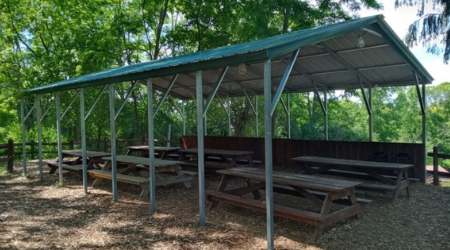
The Eagle View Pavilion is one of the 3 pavilions at the Utica Zoo. This one borders the Bald Eagle and African lion exhibits and is located near the back end of the zoo. While it is often used for zoo camps, birthday parties, and other activities, if the pavilion is empty and the "reserved" signage is not present, feel free to use this location to take a break, have a seat, and maybe enjoy a bite to eat at one of the picnic tables.
All of our pavilions are available to be rented for your own personal events! To find out about availability and to inquire about renting the Eagle View Pavilion, Click here!
Zebra View Pavilion
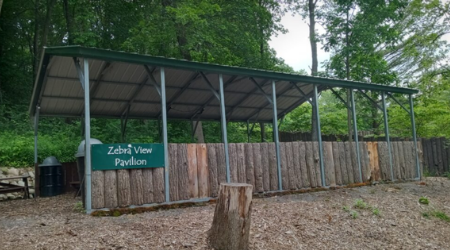
The Zebra View Pavilion is one of the 3 pavilions at the Utica Zoo. This one is located just to the left and up a small hill from the zoo's entrance. It is nestled in-between the Hartmann's Mountain Zebra/Ostrich exhibit and the Striped Hyena Exhibit. While it is often used for zoo camps, birthday parties, and other activities, if the pavilion is empty and the "reserved" signage is not present, feel free to use this location to take a break, have a seat, and maybe enjoy a bite to eat at on of the picnic tables.
All of our pavilions are available to be rented for your own personal events! To find out about availability and to inquire about renting the Zebra View Pavilion, Click Here!
Rotary Pavilion

The Rotary Pavilion is one of the 3 pavilions at the Utica Zoo and is also the largest. This pavilion often acts as the heart of the zoo where most visitors sit down to eat their lunches. It is located right across from our gorgeous Watering Can Garden and directly between our *seasonal* concession stand Polly's and Wadas' Wild Play Park. While this pavilion is occasionally rented out, it is typically available to all guests during the zoo's normal operating hours.
All of our pavilions are available to be rented for your own personal events! To find out about availability and to inquire about renting the Rotary Pavilion, Click Here!
Wadas' Wild Play Park

Wadas' Wild Play Park is the recently expanded play area here at the Utica Zoo. It was constructed thanks to grant money and a generous donation from Wadas Eye Group. Here you can find fun for all ages!
Walmart Amphitheater

During certain events at the Utica Zoo, the Walmart Amphitheater is used to host various shows and attractions. These include story readings, magic shows, and lots of other fun-filled activities for all ages. If an event is going on at the zoo, take a look at the schedule to see if anything is going on at this lovely location!
Polly's Concession Stand

Our concession stand Polly's is OPEN from 11am until 4pm every day through Labor Day! It is operated by Kookie's Q!
We also do have a selection of snacks - such as chips and ice cream - as well as cold drinks inside our giftshop.
Visitors are invited to bring their own food and drink items to enjoy while on Zoo Grounds. We ask that items containing allergens (peanut putter, gluten, etc.) are not brought into the Playground area, located below the Rotary Pavilion deck.
Restrooms
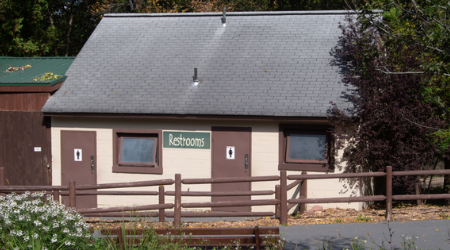
A much needed stop for most visitors! At the moment, it is the only public restroom on zoo grounds. If there is ever an issue that you have with this restroom, please bring it to the attention of our staff at the Tree Top Gift Shop and they will contact the appropriate staff members to resolve the issue.
New York Energy Zone

While not exactly part of the Utica Zoo, NYPA's New York Energy Zone is our next door neighbor here in the Roscoe Conkling Park and we collaborate on many projects. Here you can find various attractions on electricity! The following description was taken right from their website:
"The NY Energy Zone will introduce you to the dynamic world of electricity, past, present, and future, and New York State’s part in it. Interactive exhibits, activities, movies and videos meet you at every turn. Plus you will learn about NYS’s exciting electric history, its great electric companies and the important work at NYPA’s Frederick R. Clark Energy Control Center in nearby Marcy.
Are you ready? An electrifying experience awaits...
- Activate and personalize your Power Pass with an avatar
- Step into the zone with our 3-D immersive movie experience “Imagination!” in the Magi Theater
- Travel back in time with Nikola Tesla and Thomas Edison
- Build a bulb, a power plant, microgrid, solar and wind installation
- Become a control room operator
- Explore the 'Future of the Grid' room and watch the sparks fly
- "Fly" a drone over power lines
- Plus enjoy photo op moments and more
This facility is typically open every day from 10am-4pm with FREE admission, however - due to the rising COVID infection rate in the area - they have temporarily closed their doors to the public.
Discovery Cottage

This cottage is typically used during events for show-and-tell educational purposes. If you ever see one of our Docents or staff members with an animal or display set up over here, feel free to go over and talk to them!
World's Largest Watering Can
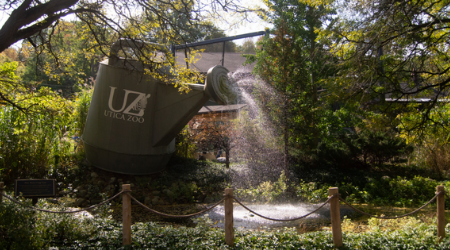
Yes, you read that right! Right here in the center of the Utica Zoo, we have the World's Largest Functional Watering Can as determined by the Guinness Book of World Records. It weights over 2000 lbs., stands at 15.5 feet tall and 12 feet in diameter, and has a volume of 1,753 cubic feet. How did this Watering Can come to be at the Utica Zoo, you ask? Well, its an interesting story!
Originally commissioned by former Utica Mayor Ed Hanna as an addition to Utica City Hall's Hanna Park, plans were later altered and the Watering Can arrived at the Utica Zoo on December 5, 2000. It sported a solid gray color up until August 1, 2019 when the Utica Zoo logo was added to serve as a location marker for visitors to the Utica Zoo.
Today, it is one of the most photographed locations in the zoo!
Nature Play Area
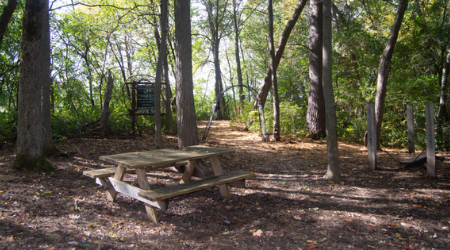
Up on the North Trek Hiking Trail you will find a series of hands-on activities that you can give a try! Want to try balancing like a squirrel in the treetops? Want to try crawling through dense underbrush like a mouse? Want to learn about food webs? All of these and more are available for you up here on North Trek! And for anyone looking for a more relaxed nature experience, take a seat at one of our North Trek picnic tables and enjoy the natural surroundings!
*Currently, the North Trek Hiking Trail is the epicenter of an exhibit upgrade for our Canada Lynx AS well as a complete revitalization/overhaul project! Due to this, there will be a few construction areas and a few of the interactive activities will be unavailable!*
Auditorium

While normally closed to the public, our Auditorium is used primarily for events, zoo camps, and special occasions. However, it is always a useful landmark to have while navigating the zoo!
Attached to the auditorium there are 2 other buildings, however. On the left is the Scales & Tails wildlife hall that features a selection of snakes, lizards, and small primates. On the right is our veterinarian area and Ambassador Animal back holding both of which - are closed to the public as well. However, during the nicer weather months you may get to peek inside the Ambassador Animal back holdings through some small windows on the right side of the building (close to the restrooms).
Pangea Plaza
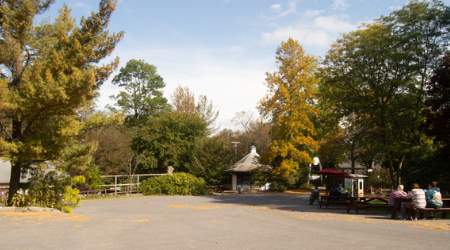
This is the central hub within the zoo. From here, you can find pathways leading toward any section of the zoo. Oftentimes during events, this is where you will find LIVE music and food trucks!
Tree Top Gift Shop
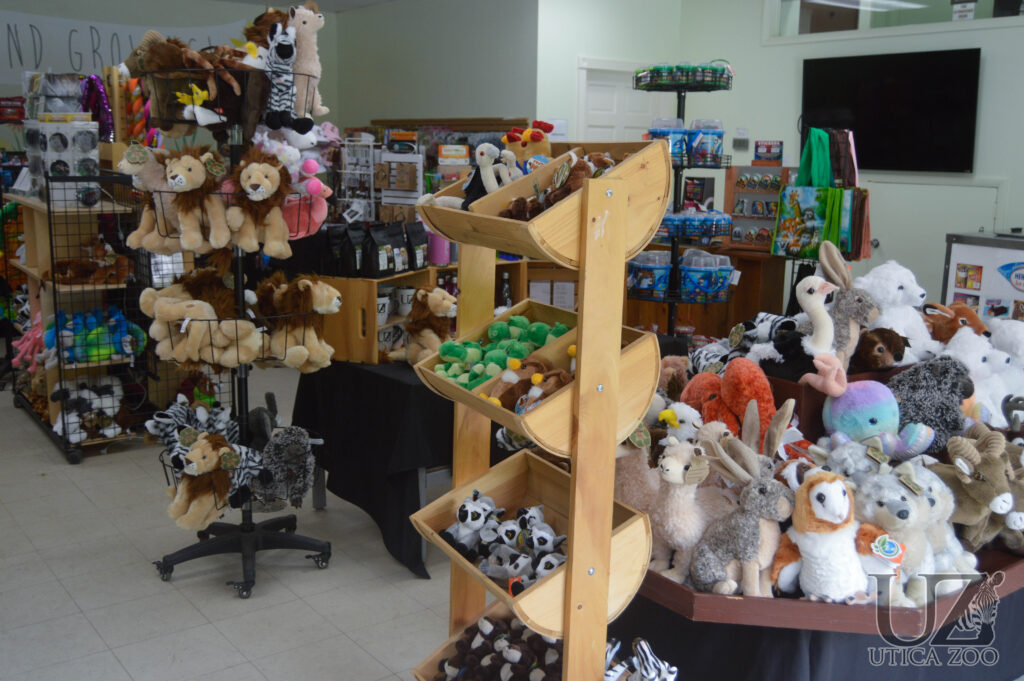
Looking for a souvenir? Maybe a special and unique gift? Then stop by our Tree Top Gift Shop and take a look around! We have stuffed animals, magnets, post cards, jewelry, action figures, apparel, bottle openers, and so much more!
The Tree Top Gift Shop also functions as our visitor experience hub! So if you have any questions or concerns, please speak to our staff members here. They would be happy to help!
Entrance/Exit
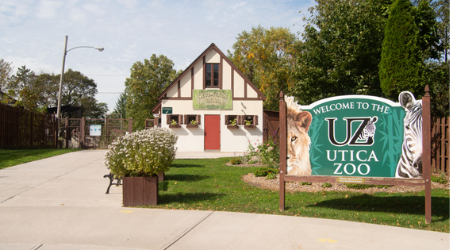
Welcome to the Utica Zoo! Thank you for coming in for a visit today! Feel free to walk right up to our ticket window and we will be happy to help you!
Optical Viewers
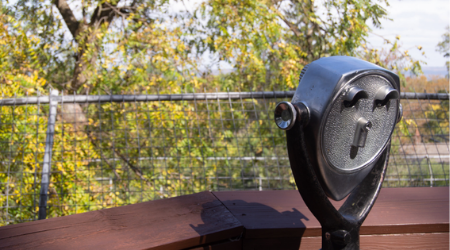
Have extra quarters? Want a better look at our Lion Exhibit? Use this optical viewer to see our lions and their habitat up close!
Suggested Wheelchair Turnaround

Beyond this bridge lies uneven terrain and gravel roads! If you have a wheelchair or a stroller, it may prove difficult to navigate this trail!
Suggested Wheelchair Turnaround
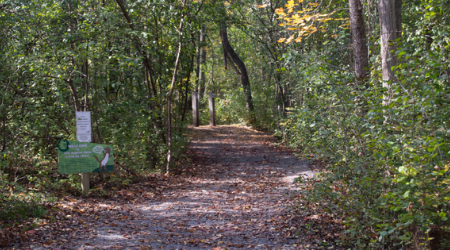
Here begins our North Trek Hiking Trail! This half mile path is designed to emulate an Adirondack Trail and so it isn't paved. Consequently, visitors using wheelchairs or strollers may find it difficult to navigate.
Utica Zoo Adirondack Chair
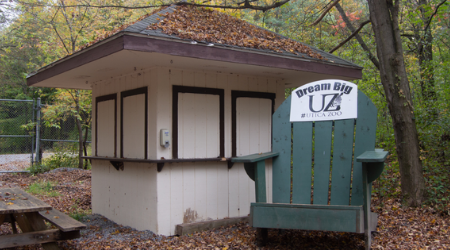
Want to make some memories? Squeeze your whole group onto this gigantic, wooden Adirondack Chair and take a picture together! It's the perfect spot to capture a photo book memory!
Ambassador Animal Viewing
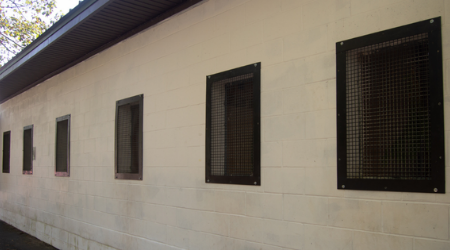
Our Ambassador Animals are animals who go off grounds to participate in outreach and education programs (such as ZooMobiles) around the greater Utica area. Because of their "job" here at the zoo, they are provided some more calm and quiet back-holdings for when they aren't "working" so that they can decompress and no get stressed out. However, during the warmer weather months you might be able to get a peek at some of these hard-working critters by glancing through these windows! Just remember to be kind and respectful towards them; it's their day off!
To see a list of our Ambassador Animals, Click Here!
If you are interested in meeting some of them, look into booking an Ambassador Animal Encounter Here!
Scales & Tails
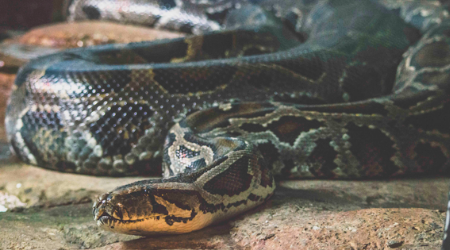
Scales & Tails is one of the 6 sections of the Utica Zoo! Located inside our Wildlife Hall building (to the left of the auditorium), this building features a variety of scaly critters and a few small primates. From snakes to lizards to tamarins, to meet all of the animals that call this section home, Click Here!
Photo Booth
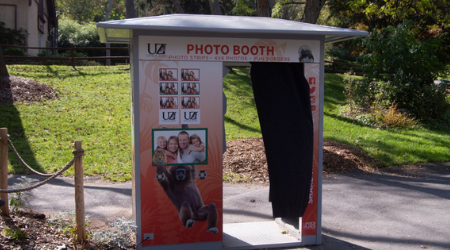
Make some memories at the zoo with your loved ones at our Apple Photobooth and get 2 photo strips for $5! This booth also allows you to email your photos to yourself AND post your photos directly to social media.
If you encounter any issues with this photobooth, go to PhotoRefund.com to inquire about refunds (the machine itself - while on zoo grounds - is owned and operated by Apple Industries)!
Picnic Area
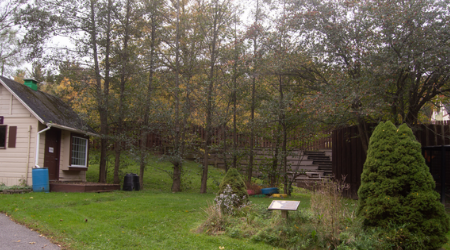
Need to take a seat? Want a more secluded place than a pavilion to eat? Then feel free to use the picnic table in this area for just that!
Optical Viewers
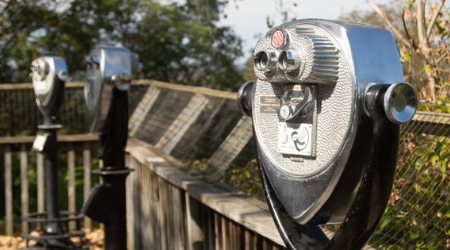
Have any spare quarters? Why not use them to take a look at the Utica skyline through these optical viewers!
Utica Overlook
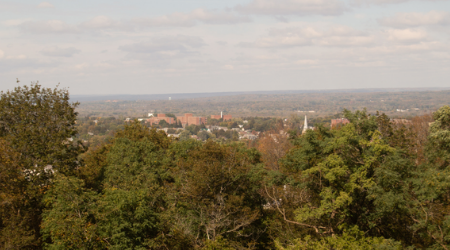
Pause here for a moment to get a beautiful view of Utica and central New York's landscape! Its perfect for a photo! And, while you're at it, try out one of our Optical Viewers to get an even better look!
North Trek Hiking Trail

The North Trek Hiking Trail is one of the 6 sections of the Utica Zoo. This half mile trail is set up to emulate an Adirondack hiking tail and on this trail you can find exhibits featuring local wildlife from Lynxes to Arctic Foxes. The trail is unpaved, however, and may prove difficult for some to navigate! To meet all of the animals who here in the zoo, Click Here!
African Ridge
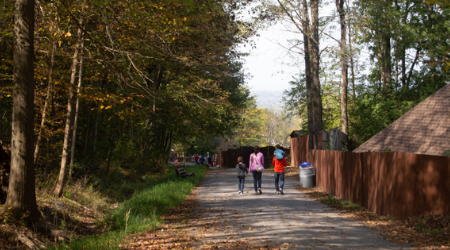
African Ridge is one of the 6 sections of the Utica Zoo! Stretching from African Lions all the way down to African Painted Dogs, African Ridge is where you can find animals from the Savannahs and Deserts of Africa! To meet all of the animals who call this section home, Click Here!
Backyards & Barnyards

Backyards & Barnyards is one of the 6 sections of the Utica Zoo! Here, you will find animals that you could find in your own backyard (provided you live in the area) OR simply animals you might find on a farm! To meet all of the animals who call this section home, Click Here!
Asian Realm
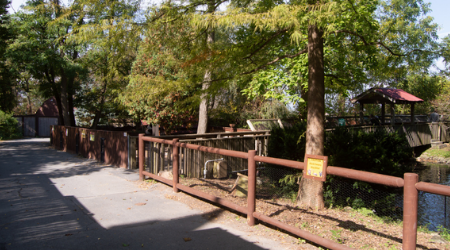
Asian Realm is one of the 6 sections of the Utica Zoo! Here you will find a variety of animals from the Asian continent from China to Mongolia to the Philippines. To meet all of the animals who call this section home, Click Here!
Forever Forests
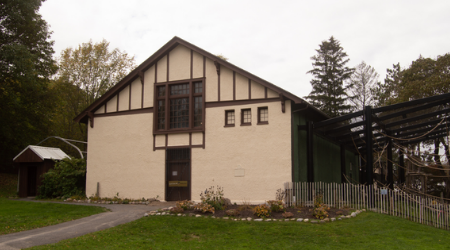
This is one of the 6 sections of the Utica Zoo! While the inside of the building is closed to the public, the exhibits featured here are entirely outside (with only back-holdings for each animals inside the buildings). Here you will find arboreal animals such as Spider Monkeys, Gibbons, and Red Pandas. To meet all of the animals who call this sections home, Click Here!
ATM

Need cash? Then use this ATM right here! A portion of the fee from this machine goes directly to the care of our animals!
FREE Parking

When you arrive at the Utica Zoo, feel free to park in any of our parking lots FOR FREE! If a day ever happens to be extremely busy, we will have staff in the parking lot to assist in parking. And occasionally - during some events - we will have shuttle buses running from the Rec Center and MVCC (if this is the case, we will specify on the relevant event page here).
Butterfly Garden
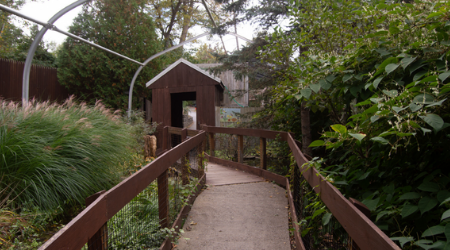
This gorgeous spot of the Utica Zoo is called out Butterfly Garden. Once every year, we release a roost of butterflies at this very spot to mingle among the flora. While the butterflies don't always stay around, it is still a nice spot to walk and get a picture!
Hummel's BME

"Locally owned and operated, Business Machines and Equipment, Inc. (BME) has provided office solutions throughout upstate New York for over 25 years, with new leadership in 2014. With offices in Greater Utica and Syracuse, and a distribution center in Mohawk, BME has grown significantly by providing quality service and products that customers have come to expect - fast and reliable at the best value."
To learn more about BME, visit https://www.bmecompany.com/.
North American Porcupine
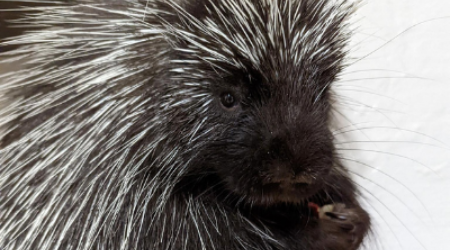
The North American Porcupine are solitary animas that can become offensive when threatened. They prefer hard and soft wood forest but can be found in Tundra and Rangeland (Grasslands) of the United States and Canada. They are herbivores who eat leaves, roots, grasses and fruits. In the winter they survive on wood, bark and pine needles. The average adult porcupine can have up to 30,000 quills.
Did you know?!
- North American porcupines are the third largest rodents in the world, followed by the capybara and the beaver. In fact, porcupines are the 2nd largest rodent in the US.
- Porcupines have the signature orange rodent teeth that never stop growing. Their teeth contain iron to aid in chewing and filing. This iron is what gives their teeth an orange tint.
- North American porcupines don't hibernate! Instead, they hide themselves in a dark place such as a cave, a den, or a tree. This can protect them from predators.
- North American porcupines spend about 3/4ths of their lives in trees! Their curved nails aid in climbing.
- The average adult porcupine has close to 30,000 quills of varying sizes. They cannot shoot these quills!
- North American porcupines are nocturnal meaning that they are mostly active at night!
Our Porcupines:
Widget (Male) - Born April 19, 2010
Prickles (Female) - Born May 5, 2020
Patagonian Cavy
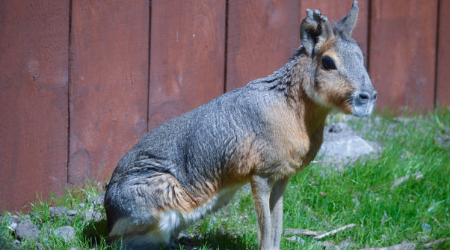
Also called the Patagonian mara or Patagonian hare, Patagonian cavies are a small species of mammal found ONLY in southern and central Argentina. They typically reside in arid desert and scrubland habitats. They spend most of their time in monogamous family units, but do come together in larger groups when breeding as a way to protect their young. They communicate through a large variety of different noises. They are also capable of moving in a large number of ways from walking to hopping to trotting to prancing and more. Unfortunately, due to habitat loss along with increased competition for food with domestic sheep and the European hare, Patagonian cavies are now considered near threatened as their population has started to decline.
Our Patagonian Cavies:
Plata (Female) - Born February 15, 2016
Pampa (Female) - Born February 15, 2018
Barn Owl
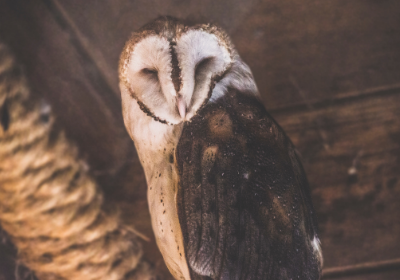
Barn Owls are one of the most common species of owls in the world and can be found everywhere except polar and desert regions and on a few islands. They are distinguishable by their white heart-shaped face, white chest, and small brown spots adorning their feathers. Their call is also not the common hoot like a lot of other owls, but a long, raspy scream. Like all owls, Barn Owls are nocturnal and use their excellent vision and hearing to silently swoop down upon unsuspecting prey in the dead of night.
Our Barn Owls
Squiggles (Female) - Estimated Birthdate May 2012
Bantam Chicken
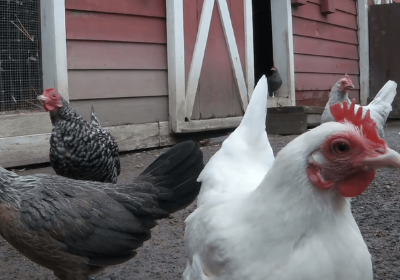
While the word “Bantam” originally comes from the Indonesian seaport of Bantam, in this circumstance it is a word given to any small species of fowl. Bantam chickens in particular grew in popularity among European sailors looking to restock their food supplies while in Southeast Asia. The small size of the chickens allowed sailors to fit larger numbers of this bird onto their ships. Today, you can find Bantam chickens in many parts of the world where people want to have chickens but have limited space to house them.
Sulcata Tortoise
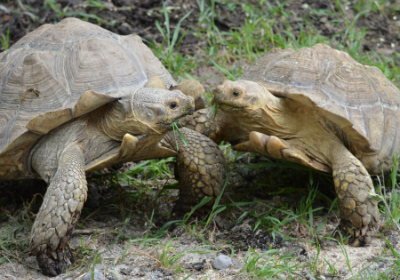
Sulcata tortoises are the third largest tortoise after the Galapagos and Aldabra tortoises. Sulcatas live in the extremely arid Sahara desert that spans the a large portion of North Africa and includes countries such as Egypt, Sudan, Chad, Niger, Libya, Tunisia, Algeria, Mali, and Mauritania. Some of these areas see as little as 0 inches of rainfall over years. Because of this, Sulcata tortoises’ skin is resistant to fluid loss, but when exposed to moisture it becomes highly permeable. This means that these tortoises spend a good deal of the day (when it is the hottest) burrowed more than 2 feet underground where there is more moisture to absorb. They then emerge between dawn and dusk to go about their routine activities. These tortoises are also very aggressive toward each other and males often ram into each other in an attempt to flip other males over.
Our Tortoises:
Bart (Male) - Estimated Birthdate Between August 2005 & August 2006
Bob (Male) - Estimated Birthdate Between 1996 & 2000
Roscoe (Male) - Estimated Birthdate Between January & July 2000
Chinese Alligator
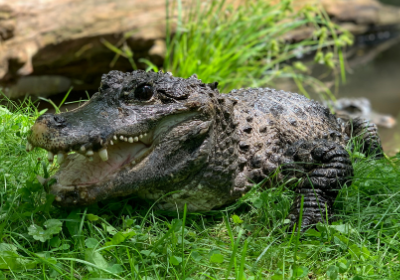
While once a prominent species across the Chinese waterways of the lower Yangtze River Basin, they were so valued that they were often represented in traditional Chinese folklore. Overtime, as farmland has spread across even more of China, these alligators have become more and more threatened due to losing areas that they can safely live AND from being killed by local farmers. In fact, they are so endangered right now that as of 2021 there were only though to be about 150 Chinese alligators left in the wild! Thankfully, there is still hope of this species! In the latter 1900s, breeding programs were implemented to regrow this species’ population in human care. As of 2016, there were estimated to be about 20,000 alligators currently in human care. Overtime, the hope is to strategically reintroduce members this group back into the wild to help stabilize their natural population!
Our Alligators:
Bizi (Male) - Born August 8, 1988
Ling (Female) - Born August 3, 1985
Special Event Ticket Window

This ticket window is sometimes utilized during special events!
Visitor Center and Gift Shop

Welcome to the Utica Zoo! This is our brand new Visitor Center and Gift Shop which opened in April 2023. Enter and exit the zoo through this building and feel free to stop by one of our restroom or pick up a fun souvenir in the gift shop.
Turtles
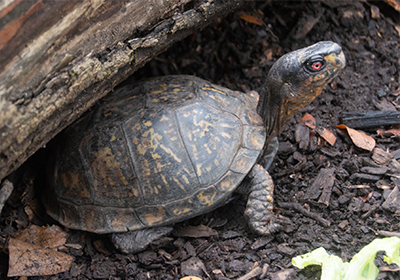
Here you will find a handful of turtles of various species!
Jumpin' Joeys' Bounce Pillow

We are always looking for new features to add to the zoo to make it an even better day out for our visitors. Over the past few years (due to being delayed by COVID-19), we have worked hard on securing and installing a bounce pillow on our grounds. This built-in trampoline will offer an additional attraction for visitors of all ages. It will be available for use at $5 per 12-mintutes (season and weather dependent)!
CONSTRUCTION SITE - FUTURE AUSTRALIAN HABITAT

We are currently in the process of installing a new habitat here that will feature a few of our Australian animals including Wallabies, Emus, and Black Swans. We will make an announcement when it is officially open!
Red Panda
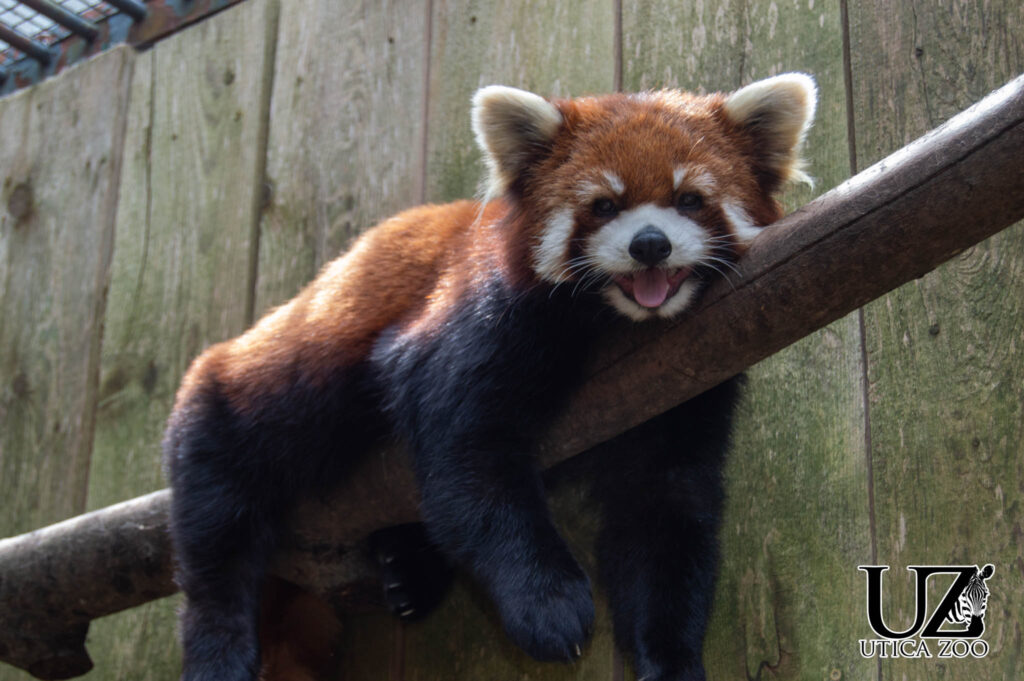
Red Pandas are usually found in the northern to west provinces of China, Nepal, India and Tibet. They can easily be distinguished by their unique rusty, red coat color. Their coat helps them blend into the canopies of Fir trees where the branches are covered in reddish-brown moss and lichens. Throughout the day, red pandas spend their time eating bamboo. In fact, despite their physiology resembling that of a carnivore, bamboo constitutes 85% to 95% of their diet. Red pandas are known to eat 2 to 4 pounds of bamboo every day! That’s roughly 20-30% of their body weight! It also adds up to about 20,000 bamboo leaves!
Our Red Pandas:
Khairo (Male) - Born June 21, 2016
Mei Lin (Female) - Born July 6, 2019
Red-Tailed Hawk
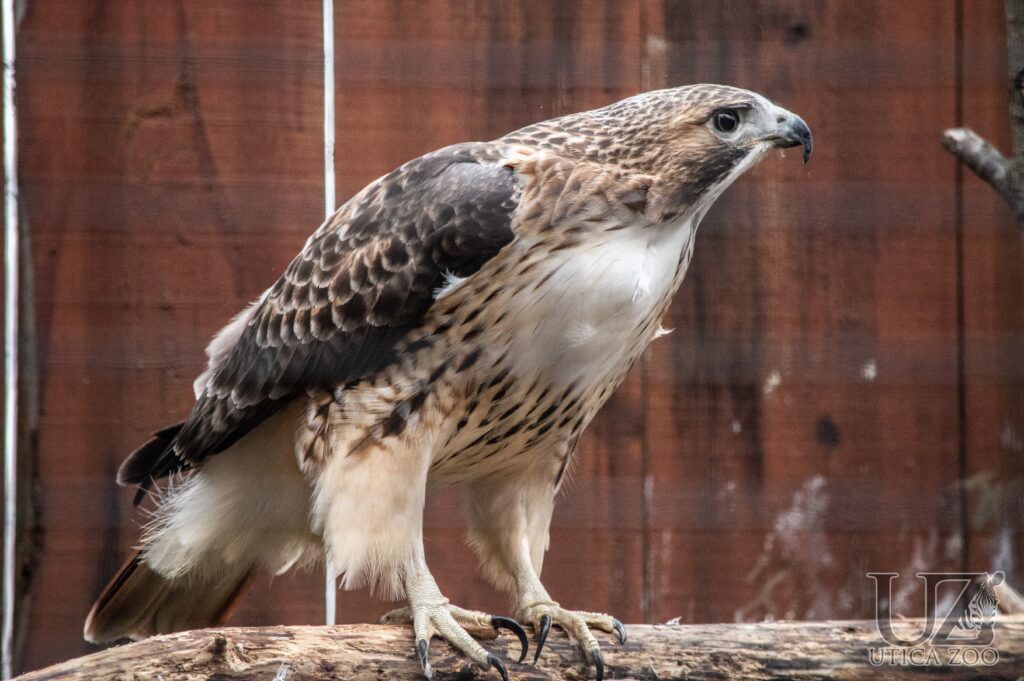
Named for the characteristic rusty, red color of their tail feathers, Red Tailed Hawks are one of the most common birds of prey in North America. Like most raptors, while Red Tailed Hawks look majestic and beautiful, don’t let that fool you. They are also formidable hunters! Their eyes are 8 times sharper than a human’s which allows them to spot even the tiniest mouse on the ground from 100 feet in the air. After this prey is spotted, a Red Tailed Hawk is capable of diving at a whopping 120mph to snatch them with their 1.33 inch talons. In fact, Red Tailed Hawks are so effective at hunting that they are able to catch a meal at least 2 to 3 times a day!
Our Red-Tailed Hawk
Tabi (Female) – Estimated Birthdate April 2018
Nigerian Dwarf Goat Babies
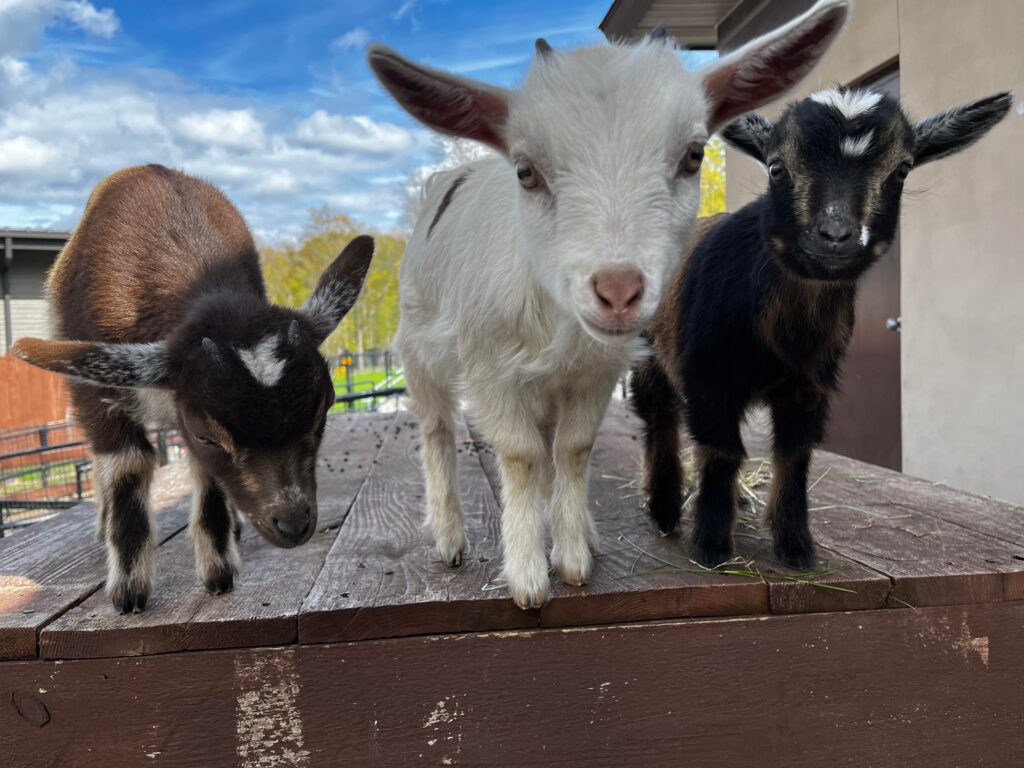
This is where you can find our new baby goats! They will be brought together with our adult goats in a few weeks after the babies as acclimated to their new home!
Nigerian Dwarf Goats derive from a variety of small goats imported from Africa to the United States between 1930 and 1960 for display in zoos. While initially used as a show breed due to their appearance and docility, Nigerian Dwarf Goats eventually became valued for their milk production as well. Today, they are recognized by the American Dairy Goat Association!
Did You Know?!
- A Nigerian Dwarf Goat doe can produce up to 2 quarts of milk per day that is higher in butterfat and protein than milk from most dairy goat breeds.
- Nigerian Dwarf Goats are often beneficial to pastures because they eat weeds and plants that many other livestock species won't touch. These weeds and plants include blackberry bushes and ivy (including poison ivy and poison oak).
- Since Nigerian dwarf goats are docile, gentle, and playful, they make very good companion pets!
African Crested Porcupine
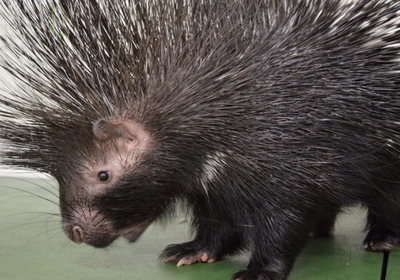
African Crested Porcupines are one of the largest rodents in the world and the largest porcupine species! Found in Northern African countries such as Morocco, Sub-Saharan countries such as Tanzania and Ethiopia, and even on mainland Italy and Sicily, unlike their North and South American cousins, they are not arboreal and spend most of their time on the ground foraging for food. Their quills are also much larger than other porcupine species and can be between 12 and 13 inches long. While they serve the same purpose of defending against predators and other threats, Crested Porcupines have a few other uses for them. After raising their quills, they tend to rattle them and stomp their feet as a threat first. If this doesn’t work, they will run backwards and slam into their target. This usually does the trick in repelling the enemy!
Our African Crested Porcupines:
Joey (Female) - Born March 16, 2012
Buttercup (Female) - Born April 2, 2018
Common Ostrich
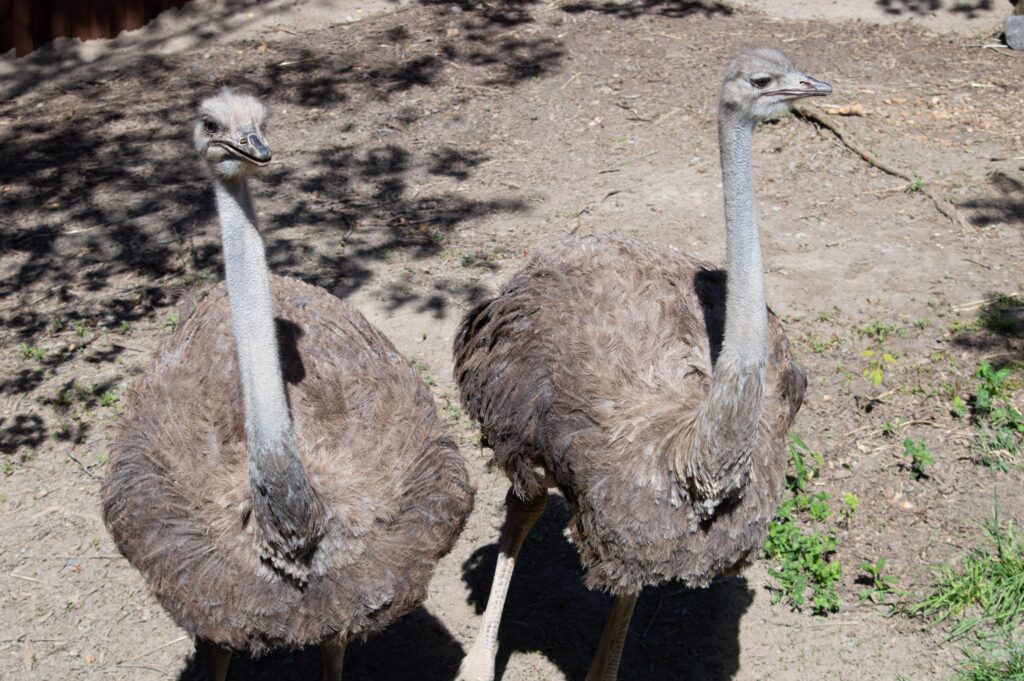
This is where our 2 newest female ostriches are located. They arrived to us mid-May and will be quarantining in this habitat for a few weeks before being introduced to our male ostrich Boomer!
Although Ostrich numbers have drastically declined over the last 200 years, they are still classed as ‘Least Concern’. In the 18th century, ostrich feathers were so popular in ladies’ fashion that the ostrich disappeared from all of North Africa. If not for ostrich farming, which began in 1838, the ostrich would probably be extinct. Today, ostriches are farmed and hunted for feathers, skin, meat, eggs, and fat.
Did you know?!
- An ostrich can run at a top speed of 43 miles per hour for a short distance, but can keep up a pace of about 30 miles per hour for a good amount of time. This big bird can also defend itself with the 4-inch claw on each foot. A kick from an ostrich is powerful enough to kill a lion!
- The ostrich has the largest eye of any land animal. Its eye is bigger than the worlds smallest bird, the Bee Hummingbird. Their eyes measure 2 inches across.
- A kick from a common ostrich – which have 4-inch claws on each foot – is so powerful that it can kill a lion.
- When a Common Ostrich eats, food is collected in the crop at the top of their throat until there is a large enough lump to slide down their throat. Consequently, Ostriches tend to swallow just about anything from plants and small animals to sand, pebbles, and small stones – the latter three of which help to grind up food in an Ostrich’s gizzard. Because of this, Ostriches are able to digest quite a lot of materials that other animals can’t eat.
- A Common Ostrich’s tough intensities are up to 46 feet in length. This allows an Ostrich to absorb as many nutrients as possible from the materials that pass through it. In fact, Ostriches do not need to drink water because they can absorb all the water that they need from the plants that they eat. However, they will still take a drink from a watering hole if given the opportunity.
- When seeking mates, male Common Ostriches have a fascinating ritual. The black-and-white males use their dramatic coloring to attract the more muted, light-brown females. The male will perform a display where they sink low to the ground right before shaking the feathers on their wings while moving their tail up and down. After this, the male will spread out his wings and stamp toward the female to impress her.
- Male and female ostriches share the responsibility of incubating the eggs. To help with camouflage, the dark feathered males will sit on the nest during the night while the light colored females will sit on the nest during the day.
- While it is typically the dominant female and territorial male of an ostrich flock that mate and create a nest – which is little more than a shallow depression scratched into the dirt by the male – others will mate and proceed to lay their eggs in the “dominant” nest. However, the eggs of the dominant female are always positioned to the center of the nest to ensure the best incubation and protection.
- Ostrich eggs are approximately 6 inches in length, 5 inches across, and weigh about 3 pounds. One ostrich will lay between 7 and 10 eggs in a season, but a communal nest may hold up to 60 eggs from an assortment of ostriches.
- When different groups of ostriches meet, they may challenge each other with short chases. The winning group takes all of losing group’s the chicks with them. This can lead to some “nurseries” ending up with 300 ostrich chicks with only a few adults to care for all of them.
- An ostrich is the only bird that has 2 toes. All other birds have either 3 or 4 toes.
- Ostriches hold their wings out when they run to help them balance.
- While ostriches can gather into groups of 100 or more, most flocks are around 10.
- Contrary to popular myth, ostriches do not bury their heads in the sand! When they sense danger and cannot run away, an ostrich flops to the ground and remains still with its head flat on the ground. Since their heads are lightly colored, they blend in with the sand making it appear like it is buried.
River Otter
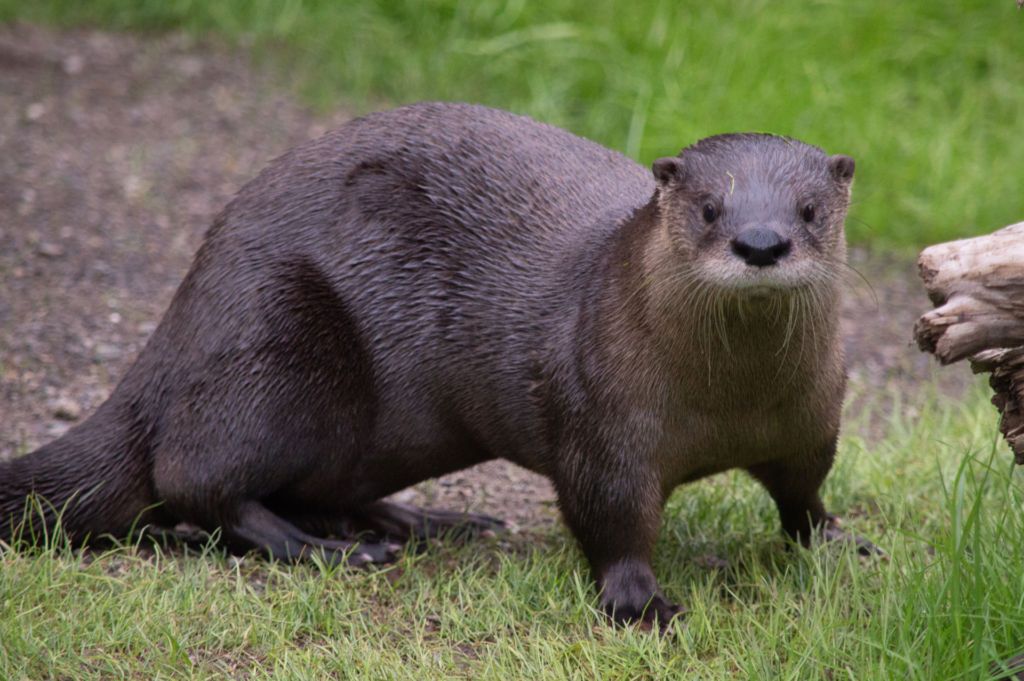
River Otters are semi-aquatic mammals found exclusively on North American coasts and waterways. They are adept navigators in the water as well as on land and can transition from one to the other with ease. This is thanks in part to their webbed paws for swimming and walking as well as their water-repellent fur. They are predators and are known to eat quite a variety of things from fish to amphibians to small turtles and small mammals. They are also commonly known for being playful and energetic. They often wrestle, chase, and swim with other otters in the wild. This is one method that these animals can learn how to hunt for food and even fight for survival if the necessity arises.
Our Otters:
Briar (Female) - Born February 5, 2021
Lily (Female) - Born February 15, 2021
Black-Crowned Night Heron
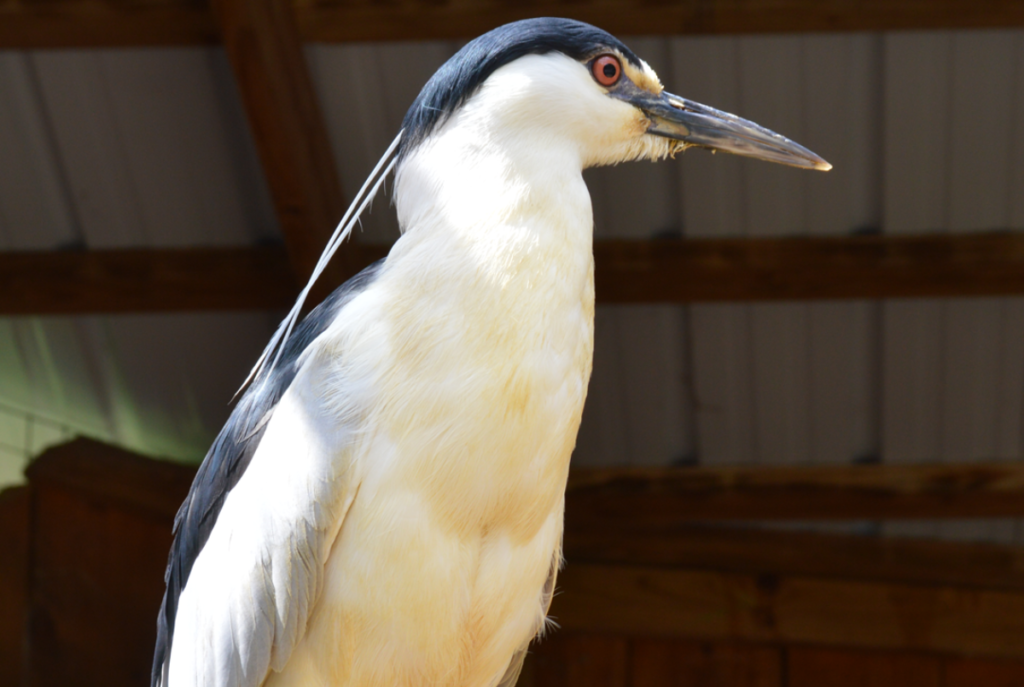
This short and stocky species of heron may look a little less impressive than its taller, more majestic cousins such as the Great Blue Herons, but they are actually the most widespread species of heron in the world. Being native to all continents apart from Australia and Antarctica, these birds often populate waterways in large colonies that can range into the hundreds. They get their name primarily from their most active time of day – between evening and early morning – where they spend a lot of their time ambushing whatever food that they can. Consequently, they are known as opportunistic feeders due to their diet which consists of everything from fish and leeches to clams and crayfish to lizards and snakes to other birds and their eggs.
Our Heron
Roman (Male) - Born May 1989
Barred Owl - COMING SOON
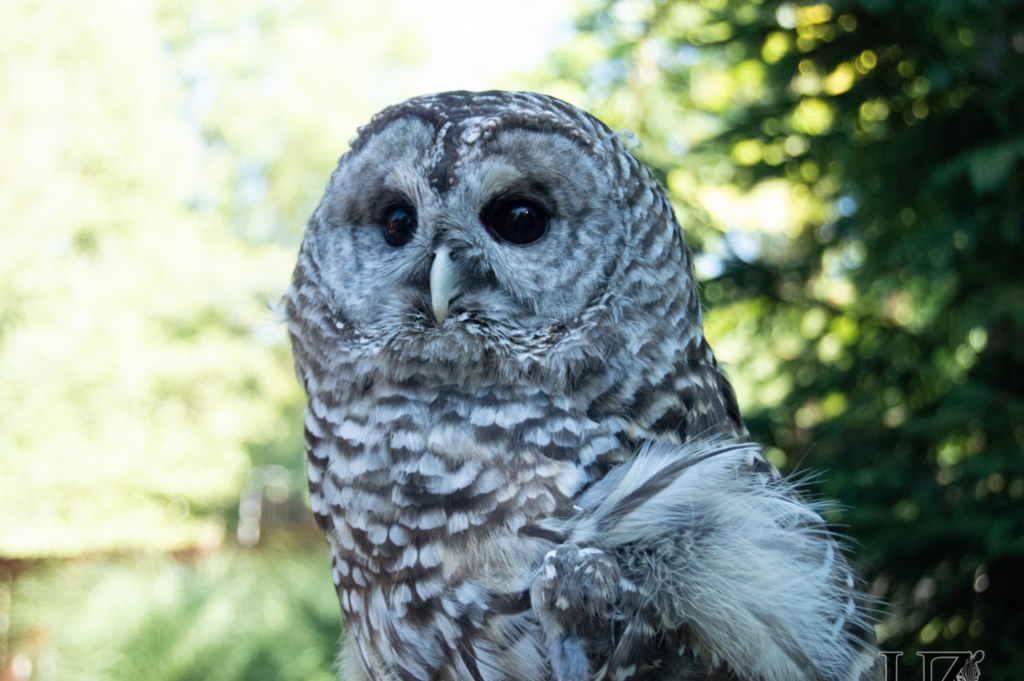
Barred Owls are one of the most common species of owls found on the eastern half of the United States! Distinguishable from their stripped (or barred) feather pattern and unique hoot (ok-ok-ok-ok ok-ok-buhooh), these owls spend most of their time sitting in trees and using their extremely powerful sight and hearing to pick out their prey. Once a target it decided upon, these owls will swoop down in near silence and snatch them from the ground. From this, Barred Owls are known to hunt birds, reptiles, amphibians, small mammals, and invertebrates. Through this, a Barred Owl tends to each between 1 and 5 prey every single day! Unfortunately, this effectiveness has led these owls to become a threat to other species around the country. Over the years, they have begun to spread their territory even more west which has them encroaching on the hunting grounds of more threatened owl species such as the Spotted Owl. In fact, Barred Owl have become such a danger to other species that they have started to be considered invasive in some parts of the Untied States!
Did You Know?!
- Barred owls are nocturnal hunters, coming out in the evening and late night to search for prey. Owls have great vision, but rely much more heavily on their sense of hearing to find prey.
- Barred owls do not migrate and actually do not move around very much. In one study, most of the owls in a group did not move more than 6 miles from the locations where they were originally spotted and banded.
- Owls are known as silent fliers. The molecular structure of their feathers differs from those that grow on a hawk, allowing them to glide through the night without alarming prey animals.
- Barred owls are smaller than great-horned owls and the latter is actually a known predator of barred owls.
- The barred owl's call is a very stereotypical "hoot" and birders often describe it as sounding similar to the question "Who cooks for you?"
- Barred owls are given their name from the "barred" pattern on their feathers.
